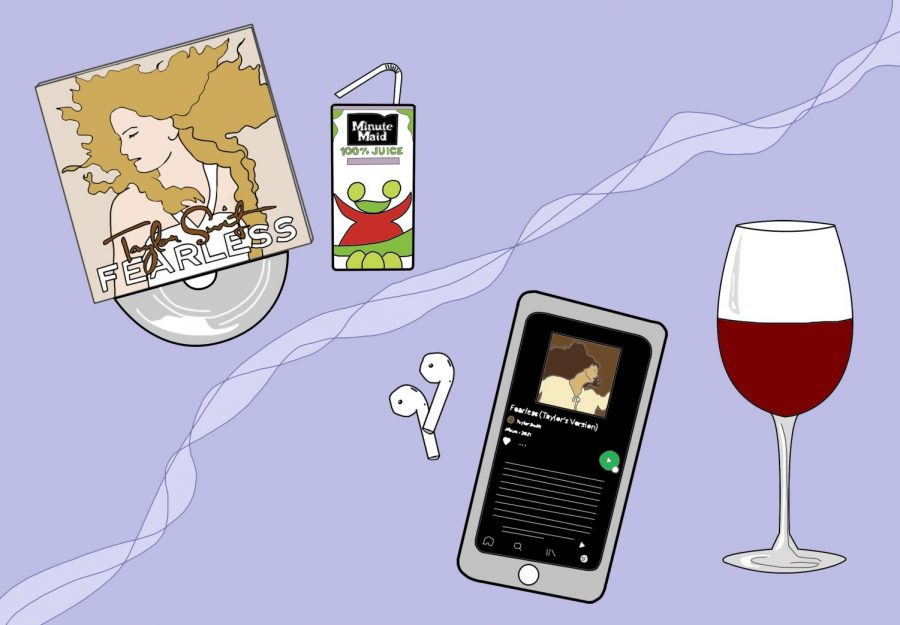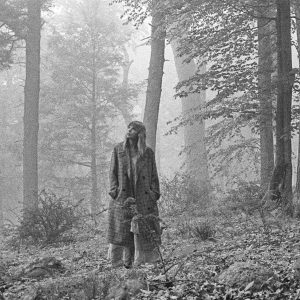‘Fearless’ Has Grown Up and So Has Its Audience
The rerelease of Taylor Swift’s sophomore album adds new maturity to markedly adolescent songs about young love and loss
April 15, 2021
In anticipation of “Fearless (Taylor’s Version),” my fellow 20-something Swifties and I have talked often about nostalgia — the welcome revival of Taylor Swift’s bygone country twang and the childhood innocence we had when the original album came out in 2008. I, for one, was in fourth grade at the time. I emphatically sang along with Swift though I knew nothing of most of the topics she sings about, problems like mean girls and teenage heartbreaks that seem so insignificant now compared to what we’ve collectively endured as young adults.
Listening to “Fearless” again on April 9, straight through as I haven’t done since my car rides to elementary school, did bring me nostalgia. I remembered “The Best Day” as the reason my mom and I started a tradition of road trip singalongs, how I almost sang “Breathe” for my first-ever community theater audition, and all the dance moves I invented to “The Way I Loved You.”
But as I listened, I didn’t feel like I was nine again, and I enjoyed the album even more that way. When I was nine, I heard the album and hoped for someone to someday pick me over the cheer captain. I wanted to tell someone off for their temper and what they said last night, and I thought the world’s ultimate excitement lay in screaming and fighting and kissing in the rain.
As a young adult, I am now able to more fully understand the songs for what they are — dramatic and occasionally petty tunes from the heart of a naive young girl — and appreciate how I’ve matured. As I listened to Swift’s voice, mellowed but confident, on each track in this rerelease, I realized she has done the same.
Swift ends up at the realization that dancing in a storm in your best dress doesn’t necessarily mean forever, and that’s OK.
Sure, she takes her moments to revel in old drama, as in the resentful “Mr. Perfectly Fine” about her breakup with Joe Jonas (but hey, if Sophie Turner can jam out to it anyway, so can we). However, the rest of the songs from the vault most clearly show Swift’s growth, or perhaps her already-extant maturity that was left out of the original “Fearless.” “We Were Happy” stands out in this regard, exhibiting a similar reserved acceptance of lost love to “happiness,” the highlight of her 2020 album “evermore” and her most mature song to date.
“Bye Bye Baby” makes a masterful new bookend to the title track. In “Fearless,” Swift sings, “With you I’d dance in a storm in my best dress,” and “Bye Bye Baby” opens with “It wasn’t just like a movie / The rain didn’t soak through my clothes, down to my skin” in a perfect lyrical parallel. Swift ends up at the realization that dancing in a storm in your best dress doesn’t necessarily mean forever, and that’s OK.
A similar matured quality is what makes the rerecorded old tracks collectively notable as a new entity, musically speaking. The instrumentals and overall sound of each are nearly identical to their original counterparts. Perhaps expectedly, it’s Swift’s tone that’s changed. She exhibits a clear distance between herself and these 13-year-old tracks that comes through differently in each song.
While appreciating how we’ve outgrown our petty adolescent troubles, we remember how high-stakes the emotions in these songs once were for a younger Swift and for us as invested young listeners.
“Hey Stephen,” for example, retains its trademark bubbliness as she gushes over a crush, but Swift now sings like she’s fondly remembering her fluttery feelings instead of being currently embroiled in them. In contrast, she sings songs like “You Belong With Me” and “White Horse” in a detached way that borders on formulaic, suggesting that she’s truly separated herself from the jealousy and melancholy those songs embody. “Tell Me Why” is a notable exception to the album’s emotional distance — Swift enthusiastically leans into the song’s angry energy more than ever, elevating the original track to standout status and showing that personal growth and the timeless fun of belting a cathartic bop aren’t mutually exclusive.
Overall, this change from the original album’s tone doesn’t make the songs less believable or disallow listeners from losing themselves in the lyrics. Perhaps that’s where nostalgia really comes in. We still enjoy these new versions after 13 years because, while appreciating how we’ve outgrown our petty adolescent troubles, we remember how high-stakes the emotions in these songs once were for a younger Swift and for us as invested young listeners.
It’s for this reason, in part, that I believe the cornerstone of the album is its original closer, “Change.” It’s been my favorite “Fearless” track since I was nine. Its rocking guitar and lyrics about tearing down walls and struggling with an unspecified “fight of our lives” have always made it seem a little out of place on an album about teenage love and heartbreak, but I loved it anyway. Singing it with abandon made me feel like I could face anything, and Swift’s own energy in the song made me feel like we were in it together.
When I first listened to the new version, I adored the unchanged dominant guitar sound and can-do spirit, but I was disappointed in the comparatively gentle quality of the song’s ecstatic final chorus. And then I realized why it works.
The original “Change” reflects grandiose dreams of an imagined victory, as Swift wrote the song before she fought many weighty battles or knew how it felt to conquer them. Today, having taken back her discography and cultivated a stronger following than ever amid slander and misogyny, she humbly sings with the knowledge that she’s faced the battles “Change” envisions — and she’s finally won.


















